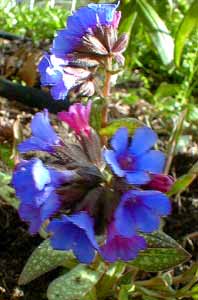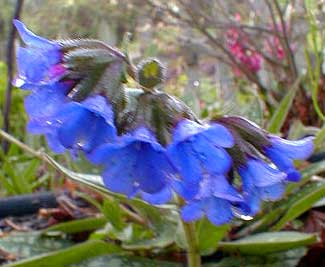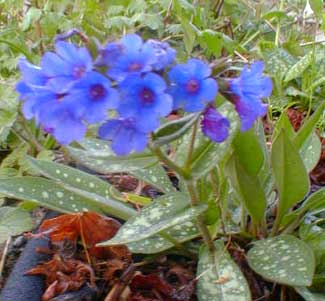
'Little Star' Longleafed Lungwort
"Every little busy bee
takes a little bribe from every little flower."
-Ivan Turgenev
(1818-1883)
(1818-1883)
I was looking for one of the deepest blues possible on a Pulmonaria, & 'Little Star' certainly fit the bill. It's dark rose-pink buds open the richest imaginable cobalt blue. Exactly what I wanted, & it was soon growing alongside the pure white-flowering Pulmonaria saccharata x officialis 'Sissinghurst White' for startling contrast.
Pulmonarias are occasionally called "Soldiers & Sailors" because like 'Little Star' they frequently have two colors of blooms on one plant. It takes a few days for each bright pink bud to become the deepest possible blue, so there will be a few pink flowers mixed among the blue.
 They flower in March before leaves appear, are still flowering in April when the spotted, lance-shaped leaves are reaching their maximum size, & will have flowers recurring right into June. Very mild rebloom can occur right up to autumn though not another great flowering until the following spring.
They flower in March before leaves appear, are still flowering in April when the spotted, lance-shaped leaves are reaching their maximum size, & will have flowers recurring right into June. Very mild rebloom can occur right up to autumn though not another great flowering until the following spring.When it is in the main finished flowering, the speckled leaves are by themselves of considerable interest. Some pulmonarias look almost diseased with their spottiness, & they are called "lungwort" for the very reason that they were once believed to possess a sympathetic magic, looking like sickly lungs because they were a medicinal treatment for respiratory illness (see my essay on The Doctrine of Signatures.
Fortunately 'Little Star' does not actually look like a diseased lung. It is fascinatingly marked as though with paint-speckling & silver clouding. The cultivar name alludes to the silvery markings of the long radiating pointed leaves, making the plant seem like a shimmering star.
 A hardy plant, it can survive suprising abuse, but if it too often experiences droughtiness or too much sun, it may become susceptible to powdery mildew. If mildew does become a problem, it can be cut back flush to the ground even before it is finished blooming, with the mildewy leaves discarded (not composted).
A hardy plant, it can survive suprising abuse, but if it too often experiences droughtiness or too much sun, it may become susceptible to powdery mildew. If mildew does become a problem, it can be cut back flush to the ground even before it is finished blooming, with the mildewy leaves discarded (not composted).When the plant is growing back, give it a spray-treatment of diluted milk once a week until the leaves are full-sized again; milk works reliably & organically, whereas fungicide sprays for mildew are neither organic nor particularly effective. With sufficient ventilation around the leaves (don't overcrowd them) & persistently moist well-draining soil, there oughtn't be a problem. Bright shade or partial shade is preferred; they will not thrive so well in deepest shade.
The plant remains smaller than the species or its several cultivars, but can still clump up after a couple of years to a foot tall & eventually two feet wide. It spreads over time by creeping rhizomes, but is slow to do so, & never invasive.
Its leaves & flower stems are more delicate of appearance than other varieties, & it is more floriferous. The previous standard for the long-petalled blue was a cultivar called 'Bertram Anderson,' which is bigger & clumpier but by most reports not quite so floriferous. The specific hybrid history of 'Little Star' begins with P. longifolia 'Bertram Anderson,' pollinated by the Blue Cowslip, P. angustifolia.
Although pulmonarias do not demand division to stay fresh for years on end, it can certainly be divided after a few years for propogation purposes. If this is done, it should be shortly after it is finished flowering, then kept moist until it recovers from inevitable wiltiness.
P. saccharata 'Dora Bielefeld'